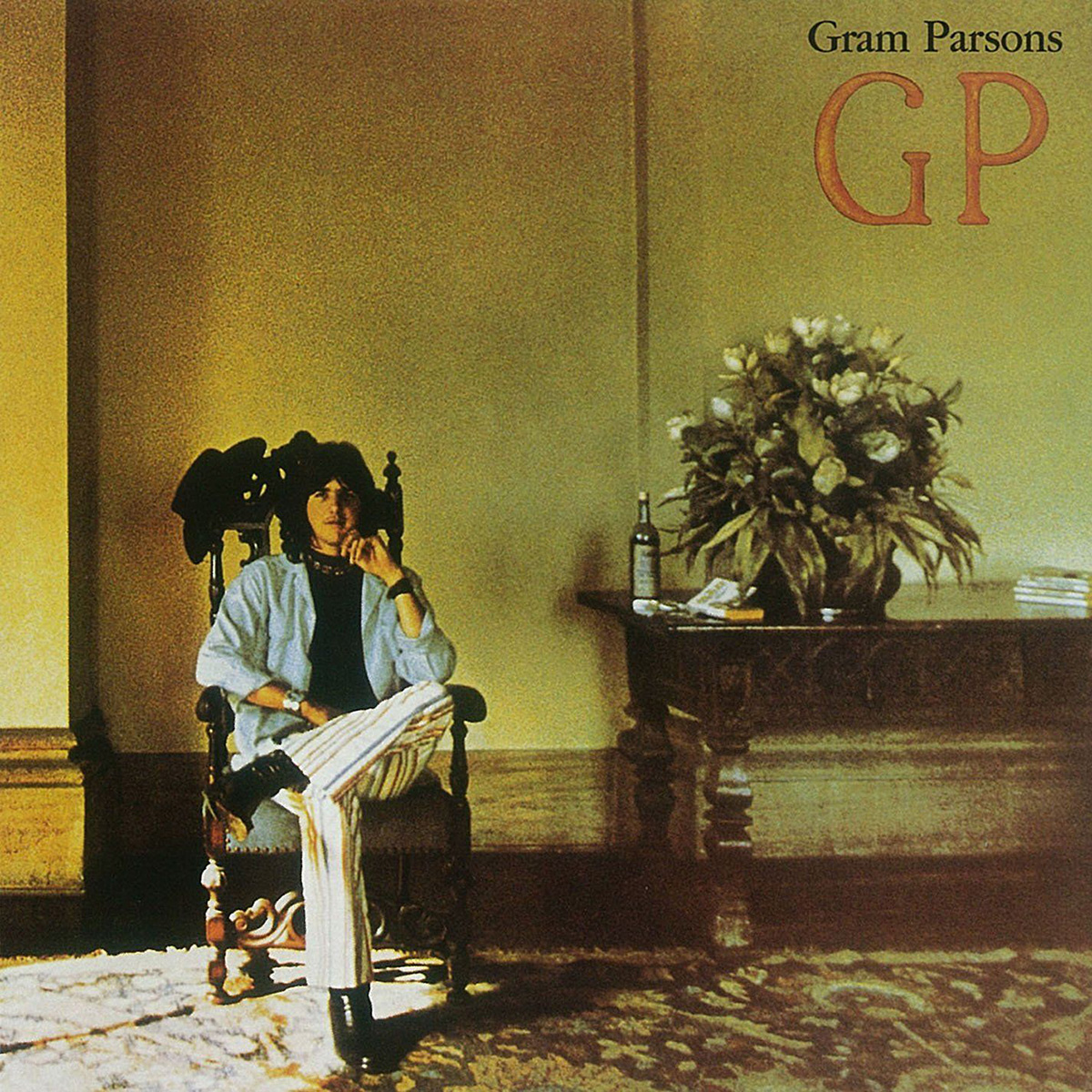
For the cover of his 1973 debut album titled GP, Gram Parsons posed in the foyer of the Chateau Marmont for photographer Barry Feinstein. At the time, he was living there with his wife in Room 47, which is one of the few rooms I haven’t stayed in and also known as the room where writer/critic/satirist Dorothy Parker hit her head on the bathtub in 1948. Parker was quoted as saying at the Chateau front desk when picking up her mail, “Life would be a bed of roses if it weren’t filled with pricks!” But I digress…In the contemporary shot below, you can see that the archways leading to nowhere have been covered with drapes. Wonder where that table ended up?

Another photo from the session shows that one of those archways actually had a doorway leading outside; next visit, I need to pull back the drapes!
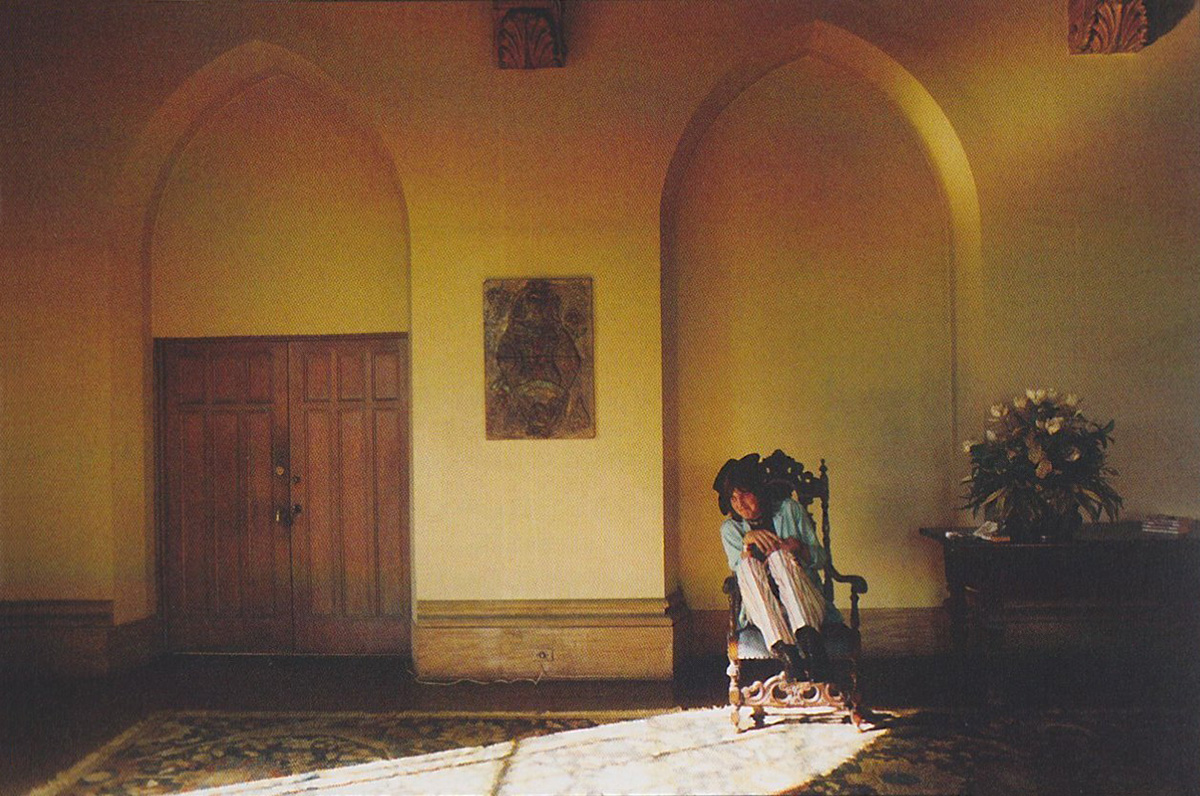
The image below was also supposedly from his room at the Chateau; by the tile on the counter, I am guessing either in the kitchen or the bathroom. I’ll let you know once I’ve seen it!

In the 1987 book Life at the Marmont (still the Bible of Chateau history), Parsons is mentioned in a section about the hotel during the early seventies:
An advertising executive from New York cleaned up the mess when a large chunk of plaster fell from the ceiling in his suite during the night. Myrna Loy and Gram Parsons carried on as though nothing had happened, after lobby chairs collapsed under them.…It is easy to understand why the owners were hesitant to spruce up the place. Why bother when no one complained? With so much plastic and glitz along the Strip, they had every right to believe that part of the Marmont’s attraction was its slightly tarnished splendor. An incoming New Yorker compared the Marmont to a theatrical backdrop. “It’s the stars who are supposed to glitter,” she said, “not the sets.”
The bottle of booze in this Chateau shot (and on the album cover) is explained by this text from Wikipedia:
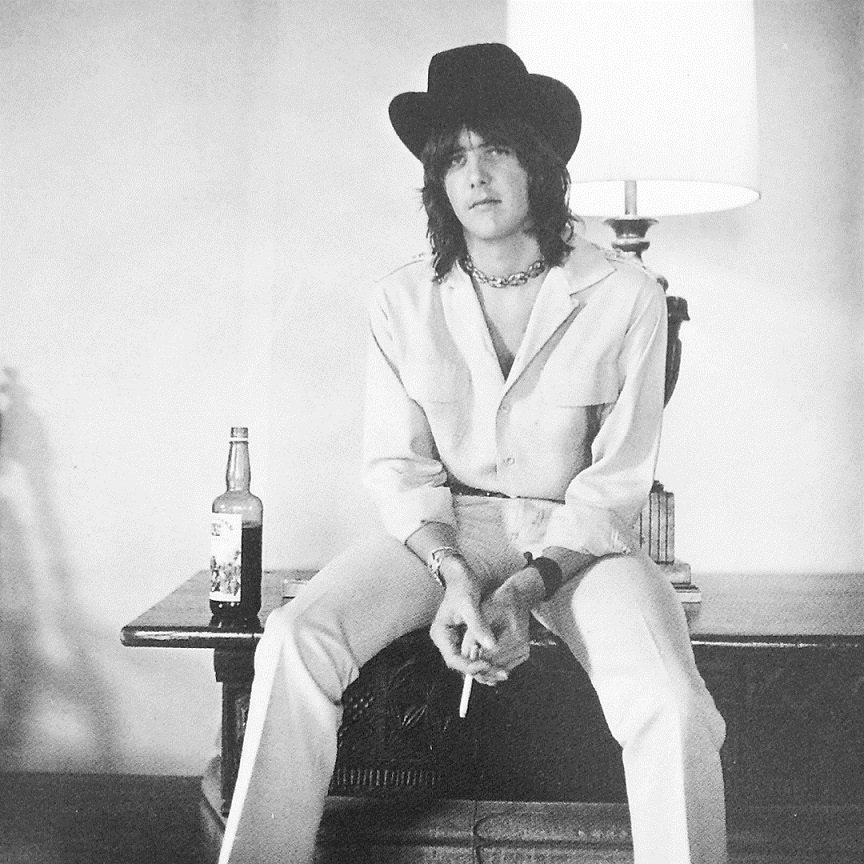
The sessions for GP ran from September through October 1972 and were produced by former Blind Faith bassist Ric Grech. Parsons was beside himself with excitement at being surrounded by such stellar musicians but also severely intimidated by their presence; in a February 2013 cover story for Uncut, David Cavanagh recalls the singer’s reticence:
“Rehearsals for GP descended into drug binges. The songs were coming together – ‘Still Feeling Blue’ (a Parsons original), ‘Kiss The Children’ (by Grech), ‘Streets of Baltimore’ (a 1966 composition by Tompall Glaser and Harlan Howard) – but Gram was falling apart at the seams. He was in the grip of alcoholism. He gorged on cocaine. He was bloated and sweaty; friends in Los Angeles estimated he'd put on three stone [42 pounds] since his [Flying] Burrito [Brothers] days, Singer and rhythm guitarist Barry Tashian remembers him being ‘nervously excited’ about the album, but strangely paralyzed by inaction.”
In the 2004 documentary “Gram Parsons: Fallen Angel,” Harris admits, “Gram was drinking a lot during that recording, and so there were times when he was together and times when he wasn't. I hadn't done that much recording in my life but I thought, ‘If this is the way people make records, I just don't get this.’” Realizing he could be blowing his big chance, Parsons cut back on his drinking and finished the sessions.
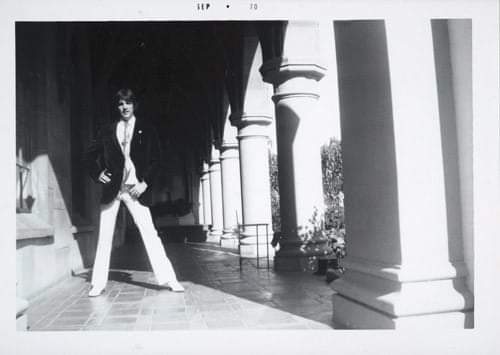
I found the September 1970 photo above on Facebook, where the poster purports it to be of Gram at the Chateau, but based on the comments it may not be. The location is definitely the Chateau, though:

The photo is from the Huntington Library’s recently acquired Eve Babitz collection. Edited from the Huntington website:
Eve Babitz was born in Los Angeles in 1943. Raised with her sister, Mirandi Babitz, in a world of painters, authors, and composers—her godfather was composer Igor Stravinsky—she attended Le Conte Junior High School and Hollywood High School. Babitz wrote, “In most high schools, you learn social things along with the rest of it. In mine, I learned irrevocably that beauty is power and the usual bastions of power are powerless when confronted by beauty.” Babitz was never shy about leveraging her own attractiveness, famously writing to Joseph Heller, author of Catch-22, “Dear Joseph Heller, I am a stacked 18-year-old blonde on Sunset Boulevard. I am also a writer.” Later that year, she was sitting for a now-iconic photo in which she plays chess in the nude with a fully dressed Marcel Duchamp.
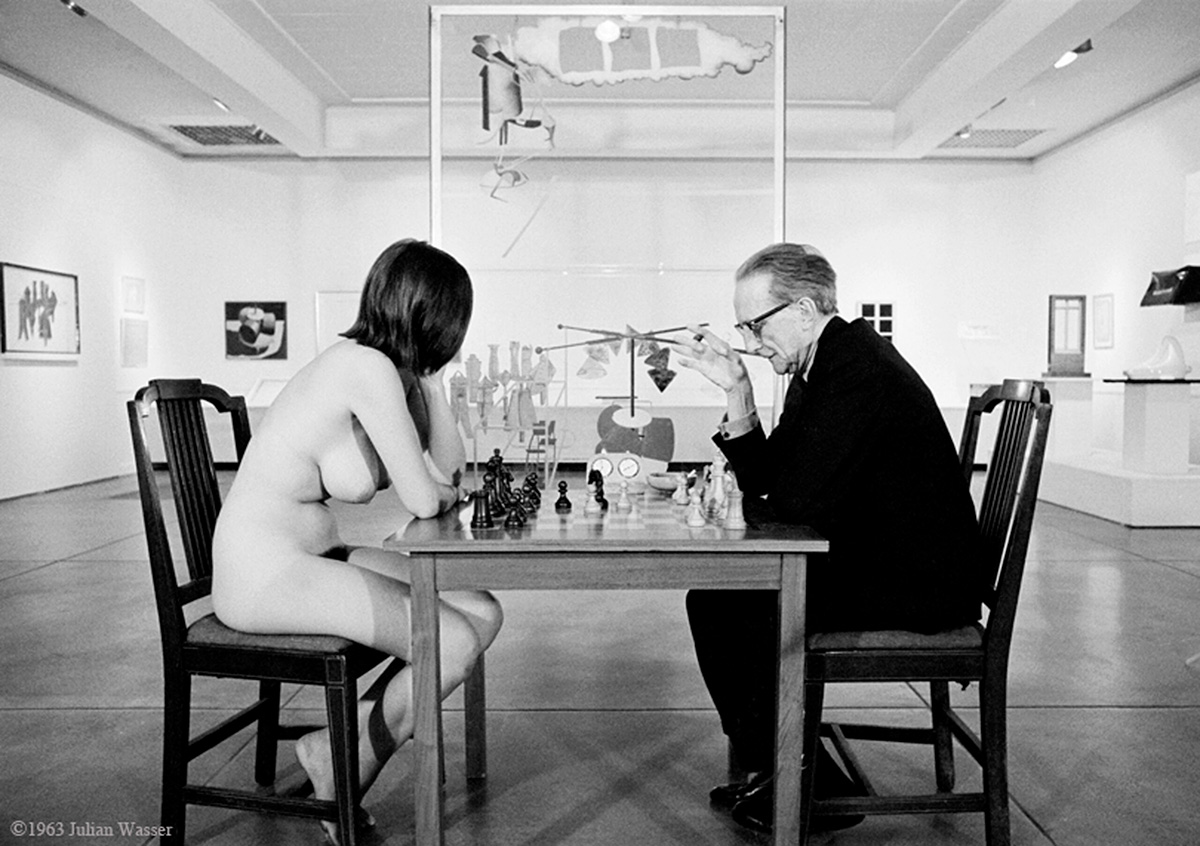
Babitz’s young adulthood was the stuff of Hollywood fantasy: She partied with Jim Morrison, the Eagles, and other rock and rollers who passed through the Chateau Marmont; hobnobbed with the literati at Joan Didion’s house; interviewed Janis Joplin; and was invited to an endless stream of parties surrounded by the bohemian beau monde of her time. Not just a groupie, but an artist among artists, she first pursued collage, and many of her works appeared in magazines and on record albums. But Babitz wanted to be a writer, and after early encouragement from Heller and Didion, she published her first piece, “The Sheik,” in Rolling Stone magazine in 1972. Two years later, she published her first book, Eve’s Hollywood (1974), and followed it with Slow Days, Fast Company (1977), Sex and Rage (1979), L.A. Woman (1982), and Black Swans (1993). In addition to Rolling Stone, Babitz contributed articles to The Village Voice, Vogue, Cosmopolitan, and Esquire, bringing to light an “only in LA” world of rock star lovers and over-the-top parties from the epicenter of cool.
In 1997, Babitz was severely burned when she accidentally dropped a lit match onto her skirt. She soon stopped writing and disappeared from public life. Then, in 2014, Vanity Fair published Lili Anolik’s retrospective on Babitz, “All About Eve—and Then Some.” That article was followed by a stream of others, which—along with the reissuing of most of Babitz’s books—brought about an Eve Babitz renaissance of sorts. Babitz, who died on Dec. 17, 2021, from complications of Huntington’s disease, found a new generation of readers in the last decade of her life. The Los Angeles Times and the New York Times published laudatory obituaries, notable achievements for an author who felt snubbed by the New York literary establishment earlier in her career.
According to Mirandi Babitz, “When I told Eve that The Huntington was very interested in her archive, she said, ‘I would love to be with Blue Boy and Pinkie again, like when we were kids. It’s as classy as the Beverly Hills Hotel so I know I’ll be happy there.’”
The acquisition of the Eve Babitz archive is supported in part by a generous contribution from Steve Martin and Anne Stringfield.
And what happened to Gram? He sadly died of an overdose at the age of 26 on September 19, 1973. From a vintage October 1973 article from Rolling Stone magazine:
The pile of stone [at Joshua Tree] is known as Cap Rock because of the flat, ten-foot, oblong boulder that rests at a slightly cocky angle at the peak of the formation. At the base of its north side, Cap Rock’s light gray coloring is charred black, and visible in a patch of sand are bits and pieces of burnt wood the size of barbecue briquets. The debris is the remains of a coffin that contained the body of Gram Parsons, who died September 19th while vacationing at a Joshua Tree motel. The singer-songwriter-guitarist, a former member of the Byrds and Flying Burrito Brothers, was 26 years old. The San Bernardino County coroner’s office said Parsons apparently died of heart failure due to natural causes, but the exact nature would not be known until after a toxicology report was received.
Although described as a person who “lived hard” – he drank heavily at times; there was talk of heroin use – his death shocked friends and business associates. Even more startling was the series of events culminating in his cremation in the desert on the morning of September 21st. Parsons’ family had planned a New Orleans burial, but his coffin was stolen from Los Angeles International Airport. Friends claimed the cremation near Joshua Tree had been Parsons’ wish. The family – Parsons’ wife, mother and stepfather – went into seclusion.
Initial news reports made reference to a “ritual” at the cremation site, but Los Angeles Detective Sgt. John Hamilton said later the reports were “completely false.” Within a week police arrested Phil Kaufman, 38, Parsons’ road manager, and Michael Martin, 26, reported to have been a roadie with the Byrds during Parsons’ one year with the group. They were booked on suspicion of grand theft and released on $1000 bond. Two days after the cremation, and before the arrests, an anonymous source, in a telephone conversation arranged through a known associate of Parsons, told Rolling Stone: “It was done by people who really loved him . . . .
“They had this old hearse and they thought they’d wear suits and pretend to be hearse drivers, but that didn’t work, so they decided to be off-duty hearse drivers, and they made up this story about how they didn’t really want to go get this body when they had a girl all ready someplace to fuck them out of their minds; so they played that out to the guy –’Come on, we gotta get to this girl, we’re working overtime, let’s get out of here’ – like that, so they signed a name, ‘Jeremy Nobody,’ to the slip and took the body off.
“It was Gram’s request, just something he had told them not too long before he died –’If I go, I want to be in Joshua Tree and I want my ashes scattered here’ – that sort of thing.
“They resented the stepfather [Robert Parsons] who came in and arranged for burial in New Orleans and didn’t even invite the friends . . . .” Yet to be determined is just when, if at all, Parsons made his request. Was it an offhand remark, a moment of melancholy? And if so, why was the request undocumented, leaving friends open to prosecution?
Truth is definitely stranger than fiction. Stay tuned for a report from Room 47 some time in the future [note: that report can be found here: https://davelandblog.blogspot.com/2022/11/dorothy-gram-room-47.html]. Looks like I’ll need to check out the Joshua Tree Inn as well.
See more Chateau Marmont photos at my main website.

6 comments:
That is an incredible story. I never really knew much of Gram Parsons other than his name, certainly not the whole story. His body went on adventures long after death, kind of like Lincoln. I have no idea why Hollywood needs to keep making up stories when there's such good material in their own backyard. This is a feature length film, here.
Thank you so much for this deep dive. I'm staying here next weekend for my birthday and as part of an ongoing Gram in California guide I'm putting together for my blog.
-Janey
Hi Janey - I am so excited to hear your thoughts! Is this your first time staying there?
Great article on the Chateau Marmont. Eva Babitz wrote a story about Gram Parsons in Los Angeles when Gram and Keith Richards hung out together. The story is called “Rosewood Casket”.
Thanks Anon - I will check it out!
The story is contained as a chapter in her book Eve's Hollywood but she changes the name and there's some fictionalization but essentially it seems pretty damn accurate and of course it gives you a real feel for Grant's personality and her prose is phenomenal.
Post a Comment